
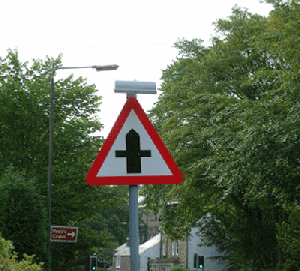 If you have been following this programme sequentially, you've already learned the basic skills needed to deal with crossroads.
If you have been following this programme sequentially, you've already learned the basic skills needed to deal with crossroads.
As you move on to tackle new things, you will use the skills in slightly different ways to suit the conditions and locations that you are driving in.
In the case of crossroads, you will be using the skills you have already practised when approaching and emerging at junctions.
You should now be familiar with using the hazard routine at junctions, and you will use this at crossroads. The main difference with crossroads is the 'extra' road. You will need to make additional observation checks to cover this road; you will also need to factor in the road users on that road when making decisions.
In addition to the crossroads covered in this section, some crossroads are controlled by traffic lights; you will find more information about these later in the course.
In addition to any specific information given here, you need to be familiar with the Highway Code rules about junctions - rules 170 to 183 - particularly 173 & 181.
It's worth noting from the start that crossroads are perfectly safe if you apply the rules in this lesson. But also keep in mind that all crossroads can be dangerous if you are not alert - this is equally the case whether you are approaching on the main road or from a side road. Never allow the fact that you are driving on the main road and have priority lull you into a false sense of security.
For videos covering all aspects of dealing with junctions visit Driving Test Success. (Google Play | App Store - appstore practical videos available as an in app purchase in the 4 in 1 kit)
Depending on your area, your driving test will probably include a number of crossroads – these might range from quiet unmarked crossroads on housing estates to busy traffic light controlled crossroads on dual-carriageways.
Regardless of the type of crossroad, your examiner will be looking for the same things; these are a routine approach, good observation and good decision making - just the same as any other junction.
If the examiner does not give a route direction on the approach to a crossroad, follow the road ahead, or look for signs that might indicate the direction you must take (for example, 'left turn only').
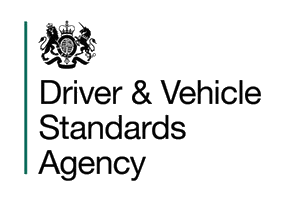 Things to consider:
Things to consider:
Use of the hazard routine
Effective observation
Compliance with signs and road markings
Correct positioning before and after the junction
Dealing with other road users safely

An easy way to make sure that your observation at crossroads is safe and effective is to remember how many roads you have to check.
One of the most common problems at crossroads is to forget to check one of the roads.
When turning right or left from a Give Way line at a crossroad, for example, from road '3' to road '1' in the diagram, drivers can often be seen looking to the right and left (just like at a T-junction) but forgetting to check the road opposite (road '2').
If going ahead (from '3' to '2'), they will leave the observation of road '2' until after they start moving.
When turning from the main road to a side road, for example, if the yellow car was turning left into road '2', drivers will look for traffic on the road ahead and the road they are turning into ('1' and '2') - but will forget the third road ('3').
By failing to check every road, you risk a crash.
You can make sure that you always look properly at crossroads by counting "One, Two, Three"!
There are always three roads to check at a regular crossroad – and it's the third road where the observation gets neglected.
The dangers of failing to check the third road (apart from failing your driving test!) are that you might not see the car or bike that is about to crash into you! If a driver on one of the other roads is also failing to count to three - to check all three roads - it will be a lot more than just a 'bump'.
Often people call these situations 'accidents'; we call them 'crashes' - the dictionary describes an accident as 'An unexpected and undesirable event, especially one resulting in damage or harm'. A crash is something that you can avoid.
If you always remember to count to three and actively look into each road for potential problems, you will be going a long way towards staying crash-free at crossroads.
Sometimes you will come across a crossroad type junction with more exits; these are usually controlled by traffic lights but not always - simply count up to four or five in these situations to ensure that you check every road.
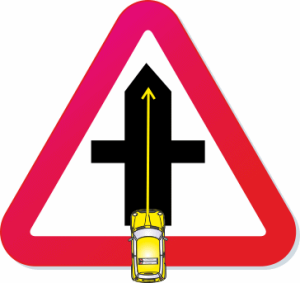
The most straightforward approach to crossroads is when you are on the main road, and the side roads each have 'Give Way' or 'Stop' signs. In other words, situations where you have priority.
But as with all junctions, you need to be careful - not everyone follows the rules!
Look for clues that might indicate that you are approaching a crossroad.
The most obvious clue that there is a crossroad ahead is the crossroad warning sign - the distance from the sign to the crossroads junction varies depending on the speed limit. Warning signs are placed earlier on fast roads.
Other clues that you are approaching a crossroad might include:
That you see traffic turning left and right ahead.
Gaps in buildings or hedgerows/tree lines.
Centre line markings changing to 'hazard lines' (long white lines with short gaps) or solid white lines.
Direction signs that show a junction ahead.
As you approach, keep checking to the left, the right and ahead for other traffic, especially cyclists and motorcyclists (these are vulnerable because they are often difficult to see).
Consider the traffic ahead. Is the car in front slowing down? If so, the driver might be thinking of turning, even if they haven't signalled yet.
Will the car coming towards you turn across in front of your vehicle? You usually have priority over approaching cars when going straight ahead or turning left, but remember, some drivers don't pay attention!
As a minimum, you need to be checking the shaded area in the diagram to make it your 'Safety Zone'. For many drivers, this is the 'danger zone' - simply because they don't keep a lookout for potential danger.
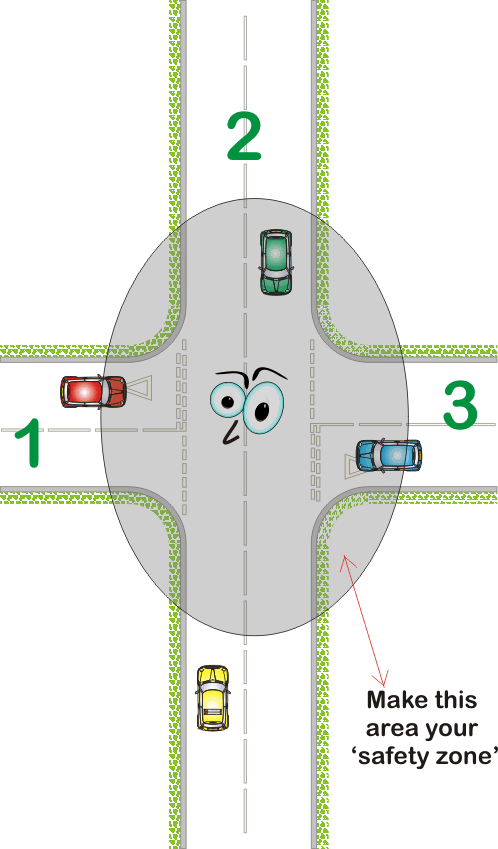
For example, if you were driving the yellow car shown in the diagram and you intend to go straight ahead, you would have priority over all the other vehicles, BUT...
The driver of the red car might not have seen the road signs, or could even have defective brakes!
The driver of the blue car might be lost and distracted by a map or sat-nav.
The driver of the green car might be lost and suddenly turn in front of you as they spot the road they want.
By easing off the gas/power pedal you can give yourself time to check all around and react if there's a problem. . In addition to easing off, you might also benefit from a lower gear to give you more control in a manual car.
Only start to increase your speed when you are absolutely sure that the road is clear and it is safe to proceed.
Your observation when going ahead will need to cover all the roads (1,2,3)
Roads 1 and 3 in case the approaching vehicles don't stop.
Also, If there were a traffic jam in road 2 ahead of you would need to stop before the junction to keep the road clear (this would allow traffic to enter or leave roads 1 and 3).
You should always be on the lookout for cyclists and motorcyclists at junctions, but this becomes even more important at crossroads, especially when turning right. Cyclists and motorcyclists can be shielded from view if they pass on the left-hand side of other vehicles.
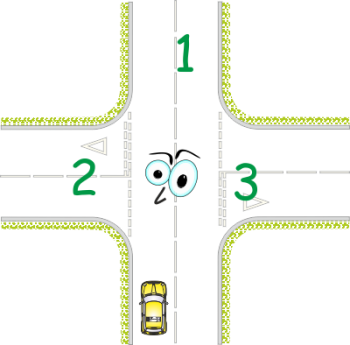
When turning, it is important to use your Mirrors, Signal, Manoeuvre routine early as you approach and then continue your observation to ensure that it is safe.
Once again, you must be sure to check the roads in all directions (1,2,3).
To turn left, you would be checking:
Road 2 to make sure that is clear and safe to turn into.
Road 1 to make sure that no one is going to cut in front of you.
Road 3 to make sure that no one is likely drive across in front of you (or potentially into the side of your car!)
When turning right, give way to approaching traffic. To do this safely, you must double-check that the road you are turning into is clear.
Your observation for turning right will be:
Road 1 to give way to any approaching traffic
Road 2 to make sure that no one is likely drive across in front of you
Road 3 to make sure that it is clear and safe to turn into.
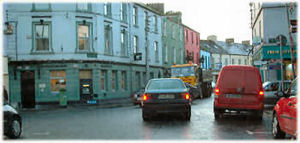
We covered 'emerging at T-Junctions' earlier in the course, so if you have been following sequentially you will already have the main skills you need. Here, we add extra observation checks for safety.
The difference between emerging at a T-Junction and emerging at crossroads is that you have to consider traffic from an extra road - the road opposite. This means that your observation is to the right, the left and ahead (1,2,3).
The photograph shows an unusual crossroad where a one-way street crosses into a two-way road. The driver in front has priority over the approaching traffic but has decided to give way; however, the picture illustrates the importance of lots of observation (as discussed on the previous page). The red van on the right is making it difficult to see clearly - have you spotted the car that is coming from the road on the right?
Sometimes you will have to wait for a while before it is safe to emerge; if this happens, check your mirrors before moving. While it's always good practice to check your mirrors after waiting at a junction, it's especially important at crossroads where cyclists or motorcyclists could be in a hurry to go straight ahead!
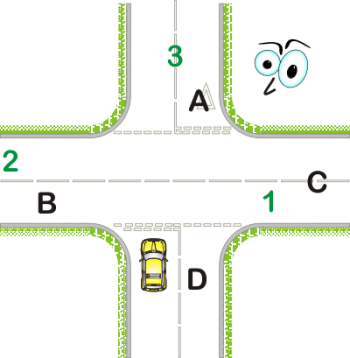
When emerging, you must always give priority to traffic on the main road (unless you are certain that they are giving way to you), but your priority over traffic from the road opposite (A) depends on which way you intend to turn.
Before giving you rule to follow, technically, vehicles in roads A & D have equal priority - regardless of the road markings. Not everyone is aware of this and some drivers (even driving instructors) will dispute the fact - so we recommend that you follow the advice below.
Give priority to vehicles from the road opposite in the same way as you would if you were on a main road and turning into a side road.
If you are in the yellow car and you:
Intend to turn left into road 'B' or go straight ahead (road 'A'), the traffic from road 'A' should give way to you because they would be crossing your path.
If traffic from 'A' wishes to turn left (C) or go ahead into road 'D' you should give way, but if it wishes to turn right (B) you have priority.
Your observation when emerging follows the 1-2-3 rule shown in this lesson. Also, be sure to check your door mirrors before you emerge, especially if you have been waiting for a while.
Check 1 and 2 for traffic on the main road
Check 3 to make sure that either the road is clear or that traffic is giving way to you.
Before going any further, the easiest way to make sense of this might be to get a couple of model cars out on your kitchen table and run through the process step-by-step while reading these notes.
Even better, download a copy of the diagram (opens in new page/tab).
Note: There might be variations in the priority rules at some junctions, for example if their are traffic lights and filter arrows. Your instructor will discuss local examples, and you will get more information as you work through this course.

Turning right has been hazardous ever since there have been motor cars, as this old 'cigarette card' shows (these picture cards used to be given away in packets of cigarettes).
The picture shows an unmarked crossroad where everyone seems confused. If you know what you are doing, it's much easier!
There are three options for proceeding when turning right at crossroads:
Scroll down the page for details of these options and their benefits and disadvantages.
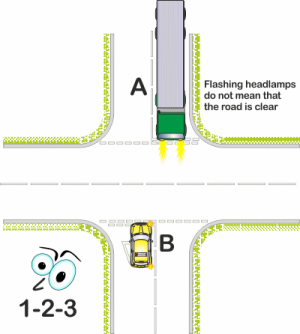
Giving way is probably the most common option at crossroads where there is not much space.
If you wish to give way, wait for the other driver. There is no need to gesture or signal that you are giving way (although eye-contact can often help); let the other driver make up their own mind.
The danger of waving or flashing your headlights is that another driver, pedestrian or cyclist might think that the signal is for them..
The lorry driver (A) in the diagram is flashing to give way to the yellow car (B), but a pedestrian waiting to cross the road might think that the flash is for them to cross in front of the car (B) with disastrous consequences.
If you want to give way to someone, you don't need to signal to them, just wait - and perhaps make eye-contact.
There will be times when others will wave or flash to give way to you, just like the lorry in the diagram. In this situation, you check all around to make sure that it is safe to proceed and that no one else is reacting to the signal, and then make the turn - never trust the flashing headlights alone, always check for yourself.
IMPORTANT: Remember that flashing headlights do not mean that it is safe to proceed - they only warn you that the other vehicle seems to be waiting.
After reading the info about flashing headlights, you will realise that it can be very dangerous.
Flashing headlights have only one meaning. Like the sounding of your horn, they let others know that you are there. See rules 110 & 111 in The Highway Code.
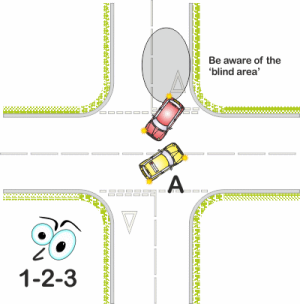
Nearside-to-nearside means driving in front of the other car, as shown on the diagram. The term 'nearside' refers to the side of the vehicle nearest to the footpath (the passenger side).
Nearside-to-nearside is probably the most common method of proceeding when drivers both move at once. But be careful - there is a large 'blind' area when crossing in front of the other vehicle.
The shaded area on the diagram shows what the driver of car 'A' can't see. The blind spot is caused by the red car (who also has the same problem because he can't see past driver 'A').
This blind spot can hide other vehicles, especially bikes and motorbikes, that may wish to go straight ahead. Ensure that you keep checking the road ahead as you drive across, and always be prepared to stop.

The offside is the opposite of the nearside. It's the driver's side of the car.
When passing offside -to-offside, cars drive around the back of each other, as shown on the diagram.
Offside-to-offside is probably the safest way to proceed because it eliminates the potentially dangerous blind spots, but on many roads, if not most roads, it is impractical for two main reasons:
The roads are not wide enough.
It can cause problems when several cars are queuing up to turn because only one car can move out of each side of the junction at once.
Another problem with this method is that because it is not widely used, other drivers might be confused if you try to drive around them.
In many situations, the safest way will be to wait until the road is clear, giving way to approaching vehicles, or wait until someone gives way to you. As you gain experience, you will get better at recognising the intentions of others through eye-contact.
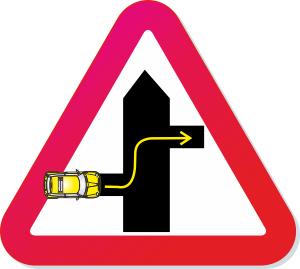
A staggered crossroad is one where the side roads are not opposite each other.
When you see a staggered crossroads sign it shows that you are on the major road and that roads will be coming in from the sides.
A sign similar to the illustration shows that the first road will be on the left and the second road will be on the right this information is useful to help guide your observation. The signs will always show the location of the side roads.
As with all junctions you need to scan the road well ahead to identify where the side roads are and look for traffic and pedestrian movement.
Look for vehicles that are turning or emerging. At some staggered junctions the side roads are quite a way apart, because of this you must always be aware that a vehicle that has pulled out of the first side road ahead of you might not pick up speed - if the driver intends to to turn off to the right.
When coming out of a side road at a staggered crossroads be aware of traffic on the main road and traffic that may emerge from the (almost) opposite side road.
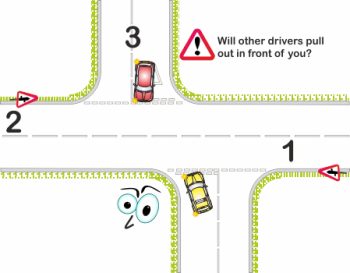
What is the red car doing in the diagram? The driver has signalled an intention to turn right but has he seen you? He might pull out at the same time as you - not a problem as long as you are aware!
If you intend to turn left and then right (or vice-versa), take special care to ensure that you don't cause problems for drivers on the main road.
When they see you pull out they will probably be expecting you to gain speed (as you would emerging from a T-junction), and could be taken by surprise when you go slowly in order to make your second turn. This means that you need to leave bigger safety margins, making sure that the gap in the traffic is big enough to allow you to complete the turns safely.
As you learned earlier, it is essential to check your mirrors after any manoeuvre at junctions. Turning at staggered crossroads are is no exception - check mirrors, make sure your signals are cancelled and adjust your speed for safety.
Some crossroads, including staggered crossroads, don't have road markings...
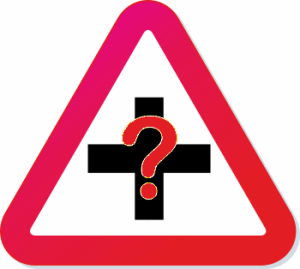
Unmarked crossroads have no road markings (as you probably guessed!).
If you've been following the information so far, you'll know that you can't automatically expect people to give way to you because signs and markings tell them to.
It's inevitable that at some point in the future, you will be 'cut up' by another driver at a junction; this might be deliberate or simply a mistake - in fact, you could be the one making a mistake!
Unmarked junctions present more room for error if you are not fully alert - you need to take special care to make sure that you know what other road users intend to do.
Here's a question for you - look at the diagram below and ask yourself:
"Which of the cars is on the major road and has priority? The red car or the yellow car?
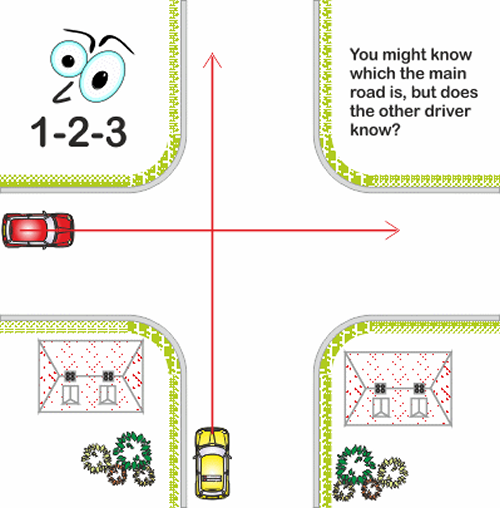
If you answered 'A' you were incorrect... And if you answered 'B' you were also incorrect!
No one has automatic priority at an unmarked crossroad, even if they are on the 'main' road! Full marks if you answered 'neither'.
Even if you are the driver of the red and you drive on that road every day, knowing it to be the 'main' road, the driver of the yellow car may be a stranger to the district and think that they have priority.
If both drivers assume they have priority, with the buildings blocking their view, they won't see each other until it's too late!
Always treat unmarked junctions, especially crossroads, with extra caution. This doesn't mean that you have to crawl at a snail's pace, but you must be able to stop if necessary.
There is a simple set of rules that you can apply to all driving situations - and this is a good place to start using it.
Three simple rules that you can base all of your driving decisions on require you to consider three things:
1. What you can see.
2. What you can't see.
3. What might reasonably be expected to happen.
If the driver of the yellow car considers these things their thinking will be something like:
"I can see a crossroad with no markings; I can't see past the houses on each side; there may be something coming on the other road who doesn't know I'm here - I'll ease off the gas until I am 100% sure that it's safe to proceed".
Applying these simple rules in all of your driving will help you become safe behind the wheel and avoid becoming a road safety accident statistic.
Click here to complete the quiz for this lesson
 (The page will open in a new window/tab)
(The page will open in a new window/tab)
You will find references for the answers in this lesson.
You can check your answers as you go along, or complete the full quiz before checking.
Leaving the check to the end is a good way to test yourself.
When you check or review your answers you will get a brief explanation of the answer.
Good Luck!

Warning Crossroads ahead

The sign warns you that there is a crossroad ahead.
The wide line indicates that you are on the main road but this doesn't mean that you can ignore the junction.
Drivers could pull out without seeing you or turn across your path to enter a side road.
Take particular care to look for cyclists and motorcyclists - also, in built-up areas pedestrians often cross the road near crossroads.
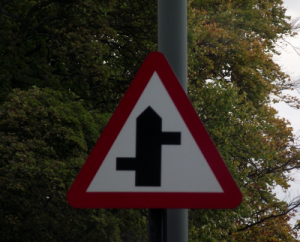
Warning Staggered Crossroads Ahead

Like the first sign shown above, this also warns you that you are approaching a crossroads but this time the side roads are offset.
Staggered crossroads have an additional risk-factor. You might expect a driver who pulls out from the left to speed up - but sometimes they will be taking the road to the right and so will stay at a low speed. It's easy to get caught out if you are not expecting this.
Apply the same 'rules' as at a regular crossroad - approach with care and look out for vulnerable road users.